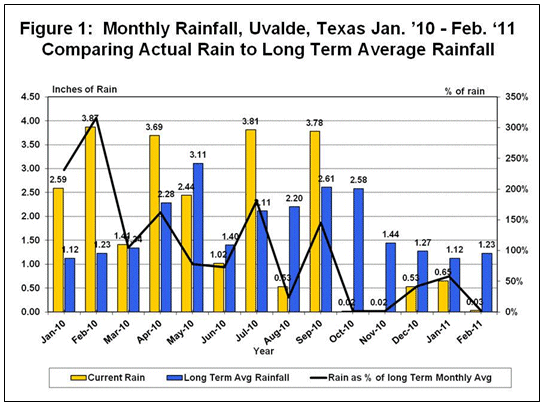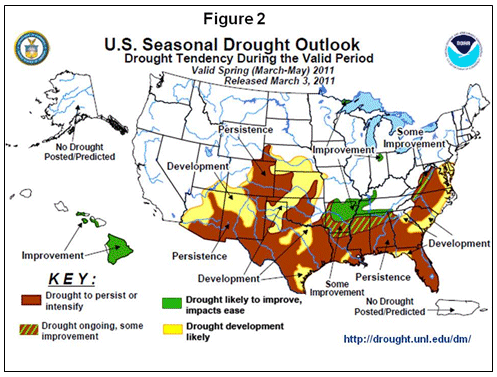Vol. 27, Issue 7, March 16, 2011 – PDF version
Jose G. Peña, Texas AgriLife Extension Economist-Management
Prices for most U.S. agricultural commodities, including livestock, have surged to record or near record highs, but a continuing dry spell in most of Texas, especially southwest Texas, may make it difficult to take full advantages of these prices. While futures prices for grains and some other commodities have shown some weakness recently, heavily influenced by the disaster in Japan, the largest importer of corn and other commodities, the disaster is expected to have only limited effect to U.S. markets, especially to beef and pork. Very tight U.S. and world supplies and strong U.S. and export demand are fueling the market.
After excellent rainfall during September ’09-July ’10, the southwest Texas region around Uvalde entered into drought conditions (75% of average rainfall) around August 2010 and has remained in a dry spell since then (See Figure 1). A large portion of Texas, especially southwest Texas may miss the spring growing season unless we get rain very soon. Reports of moisture shortages in a large portion of the South Central U.S. region, where a large proportion of the U.S. cattle herd resides, continue to appear as the time for spring green-up is rapidly approaching. USDA-NASS Texas Crop Progress and Condition report, released on March 14, 2011, ranks over 50 percent of Texas with short-to-very short top moisture conditions. Livestock and wildlife stock tanks are starting to dry and will limit livestock and wildlife production. Wildlife has become the economic lifeline for many ranching operations.
Start Planning
An early March 2011 assessment of La Niña by the national weather service indicated only slight weakening of La Niña’s strength index. The La Niña weather phenomenon results in dryer conditions across the southern tier of the U.S. as compared to El Niño which has the opposite effect. The national weather service contends that March is a pivotal month, as conditions could shift to normal, but suggests that the U.S. can expect lower yields of corn and other crops. Forecasting a potential for a weaker-to-neutral La Niña weather conditions indicates that the rainfall situation across the southern tier might improve, but the slow transition has not reached southwest Texas.
Except for winter wheat, there may be sufficient time to receive moisture for normal spring planting and growth of pastures, ranges and hay production, but it appears doubtful that rain will come in time. A month from now, it may be too late. The key to drought management is to plan ahead while there is still the maximum amount of management flexibility. Producers may have time to insure cotton, for example. Ranchers should plan to wean calves, lambs and kids early to help next year’s conception rates. And, the list of drought planning alternatives is long.
While the national weather service shows the start of a transition to maybe a weaken-to-neutral La Niña, which may improve rainfall conditions, the March 3, 2011 U.S. Seasonal Drought Outlook, unfortunately shows the drought to persist in southwest Texas at least through Spring 2011 (See Figure 2).
Appreciation is expressed to Drs. Mark Welch & Hagen Lippke for their contribution to review of this article.


